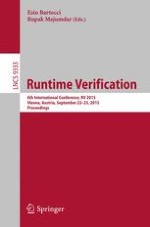This book constitutes the refereed proceedings of the 6th International Conference on Runtime Verification, RV 2015, held in Vienna, Austria, in September 2015. The 15 revised full papers presented together with 4 short papers, 2 tool papers, 4 tutorials, 3 invited talks, and 2 software competition papers were carefully reviewed and selected from 45 submissions.
The discussion of the conference centers around two main aspects. The first is to understand wether the runtime verification techniques can practically complement the traditional methods proving programs correct before their execution, such as model checking and theorem proving. The second concerns with formal methods and how their application can improve traditional ad-hoc monitoring techniques used in performance monitoring, hardware design emulation and simulation, etc.

